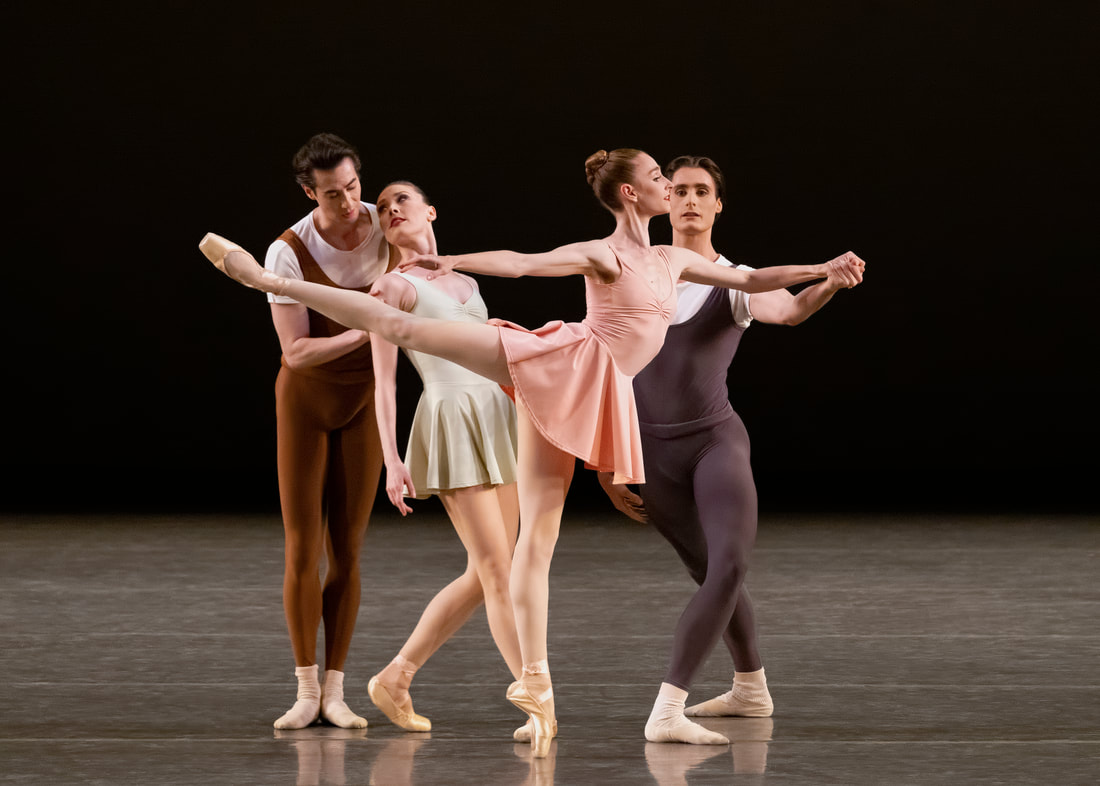|
From left is Daniel Applebaum, Emilie Gerrity, Ashley Laracey and Aaron Sanz as they appear in Jerome Robbins' “The Goldberg Variations.” (Photo by Erin Baiano) A Saturday matinee visit to Lincoln Center to see New York City Ballet has me thinking about endings – picture perfect ones that linger.
That was the case with both George Balanchine’s “Serenade” and Jerome Robbins’ “The Goldberg Variations,” which were paired on a “Masters at Work” program. The first has one of the most memorable finales in all of ballet – a standing ballerina held aloft slowly yielding to her fate in a deep backbend as the curtain descends. This beloved ending has been viewed as a religious experience, divinity in the flesh. But it is “The Goldberg Variations,” a ballet that I frankly avoided for years because of its hefty length, an 1 hour and 24 minutes, that alerted me to how much those two works have in common. It’s long because the Robbins ballet has a lot of music to cover — the popular and pleasant Johann Sebastian Bach’s piano variations, which on Saturday were beautifully performed by Susan Walters. The piece is Robbins’ way of lifting the veil of time between court dances of the 16th and 17th century and contemporary ballet and modern dance. He starts it off with a couple (Miriam Miller and Preston Chamblee) in a sarabande, wearing elegant attire reminiscent of the dancing days at the palace. The dancers hop, circle and side skip to each other as the music rises, carrying them off. After they depart, the dance turns modern with groups of men and women reflecting the music passages in ways that are sometimes playful, sometimes peaceful, sometimes passionate, but always unfolding in ways that are pleasing to the eye. (Each of these variations could easily stand alone.) Throughout, their movement emphasizes ballet’s courtly roots are ever present. Then the piece has the dancers reverts back to the ruffled historic dress and the line through the centuries continues in the opposite direction. There are 30 variations, and at times, the ballet does seem unending. Only a deep appreciation for the music can keep the mind keenly focused on every note. But back to the ending. Like “Serenade,” it has a false finale. (In “Serenade,” on first viewing, most applaud at the end of the third movement but then the central woman, on Saturday it was Sara Mearns, falls to the floor and the fourth movement begins.) In “Goldberg Variations,” it comes when the ensemble beautifully assembles itself into a wall. With some kneeling, some standing and some rising on others’ shoulders, they tightly gather and extend a hand in the direction of the pianist. And while they are posed there, the clapping begins. But then one sees Walters continue to move her fingers over the keyboard, a signal more is to come. The group dissembles and the original couple returns, this time in modern dress for the final sarabande as the curtain comes down. In the future, I won't be avoiding "The Goldberg Variations."
0 Comments
Leave a Reply. |
Wendy
|

 RSS Feed
RSS Feed
